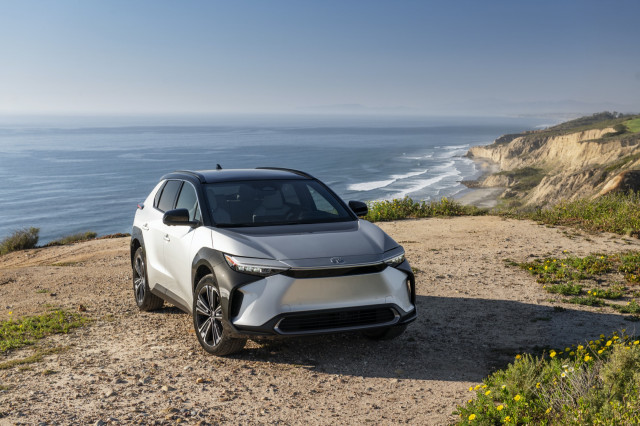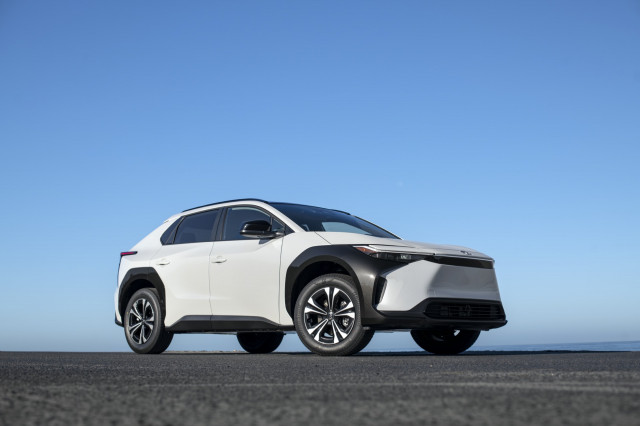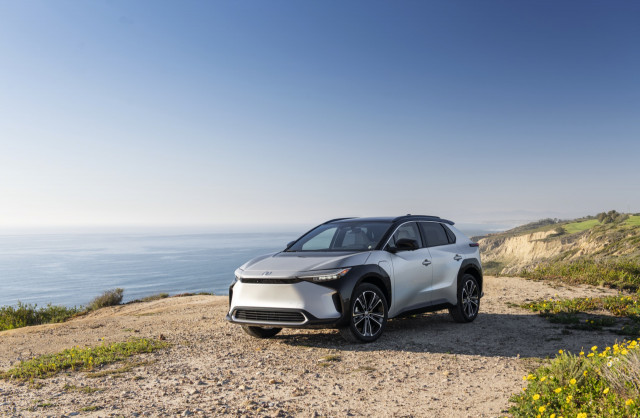LIKES
- Back seat space
- Cargo versatility
- Quiet cabin
DISLIKES
- Confining layout in front
- Cluttered interior design
- Limited availability
BUYING TIP
The 2023 Toyota BZ4X lacks some of the technology luster of its rivals, but it’s efficient, well-equipped, and easy to live with.
What kind of car is the 2023 Toyota BZ4X? What does it compare to?
The 2023 Toyota BZ4X is a fully electric SUV that offers more than 250 miles of range in some versions, seating for five, available all-wheel drive, and the ground clearance for modest off-roading. Alternatives include the Volkswagen ID.4, Hyundai Ioniq 5, Kia EV6, Tesla Model Y, and Ford Mustang Mach-E, along with the closely related Subaru Solterra.
Is the 2023 Toyota BZ4X a good car?
The BZ4X isn’t a technology or performance leader among EVs, but it’s an impressive vehicle if you place a higher priority on comfort and features. It earns a TCC Rating of 7.2 out of 10.
What’s new for the 2023 Toyota BZ4X?
The Toyota BZ4X is an entirely new model—and Toyota’s first electric vehicle intended for something more than a very limited run in California ZEV states.
The BZ4X was engineered with Subaru and built on a platform dedicated for electric vehicles. Single- and dual-motor versions provide front- or all-wheel drive, making 201 hp and 196 lb-ft and 214 hp and 248 lb-ft, respectively, with battery packs at 71.4 kwh and 72.8 kwh. Heavy battery pack aside, it’s laid out much like a compact crossover, with a four-wheel independent suspension, struts in front, and four-wheel disc brakes. The ride is on the soft side, but handling is precise.
Inside, the BZ4X is a little Prius meets utility vehicle, meets a somewhat cluttered idea of the future. If you can get past the rather confining layout in the front seats—and the instrument cluster that can be challenging to align with the steering wheel, it gets better. Seating for five is well-apportioned, cargo space has a useful dual-tier layout (no frunk though), and the rear seatbacks fold flat.
How much does the 2023 Toyota BZ4X cost?
The base BZ4X XLE with front-wheel drive starts at $43,215, including the $1,215 destination fee. The front-wheel-drive Limited costs $47,915. Dual-motor all-wheel drive adds $2,080 to either trim.
Where is the Toyota BZ4X made?
In Japan.
Styling
The BZ4X wears too much cladding and plays too many styling cards at once—although some will appreciate the nouveau-Prius layout inside.
Is the BZ4X a good-looking car?
The BZ4X is distinctive, but we don’t think many will call it attractive. We dock two points for an exterior that doesn’t come together, but add a point back for a functional interior. That’s a 4.
On the outside, the BZ4X reads a bit like a Prius crossover wearing too much Subaru Wilderness cladding.
Inside, the Toyota BZ4X channels a cockpit layout with a chiseled, sci-fi spin. It’s asymmetrical, of course, with an instrument screen pushed forward to the base of the windshield. The interior’s like a Prius gone Outback, which isn’t far from the target. Up close, we don’t at all mind the bevy of physical buttons, but there’s just too much glossy piano black and smudgeable surfaces here.
Performance
The BZ4X is quick enough, and it trades off some sharpness for an easygoing ride and trail chops.
Put simply, the BZ4X doesn’t make all the performance poses flaunted by the latest electric crossovers. The dedicated off-road mode, called X-Mode, is borrowed from Subaru, so it has plenty of outdoorsy credibility that’s rare in this cohort. We give the BZ4X a bonus point for being able to go comfortably where the pavement ends and the surfaces turn slippery. It also gets another point for docile handling and good ride quality, which fits the mission well. That adds up to a 7 out of 10.
There are two different layouts for the BZ4X—a single-motor, front-wheel-drive version making 201 hp and 196 lb-ft, and a dual-motor, all-wheel-drive version making 214 hp and 248 lb-ft. The single-motor version has a 71.4-kwh pack loaded with Panasonic cells, and the dual-motor version uses a 72.8-kwh pack incorporating CATL cells. Counterintuitively, the front-drive version gets what Toyota considers the superior pack, enabled for faster charging.
At a curb weight of up to 4,464 lb, the AWD BZ4X is about 800 lb heavier than the gasoline RAV4 crossover. You might not know that because the torquey motor system gives it a quiet punch and the low-mounted battery pack gives it an almost nimble feel. Although built on a dedicated EV platform, the BZ4X is otherwise laid out like other compact sedans and crossovers, with a four-wheel independent suspension—struts in front—plus four-wheel disc brakes and electric power steering. The steering is precise, although the turning circle of 40.0 feet is larger than other compact vehicles. Ride quality is on the soft side, and handling is tuned to be easy and predictable, not downright sporty.
The BZ4X doesn’t charge at the road-trip rate of other rival models (just 100 kw for AWD versions), but well-coordinated brake regen, a pleasant ride, and overall refinement will more than make up for it. The BZ4X is one of the few electric crossovers good for some trail driving off-pavement. On pavement, its EPA-rated 119 MPGe trails only the Tesla Model Y in electric crossover efficiency.
Is the BZ4X 4WD?
Yes. However, dual-motor all-wheel-drive versions of the BZ4X underscore a different philosophy than some other models in this competitive set, as they’re less about added traction than much-improved performance. Subaru’s X-Mode is included in all-wheel-drive versions of the BZ4X, and it allows a different torque distribution plus a little more wheelspin when you need it for snow, dirt, or mud. We haven’t tested that in the BZ4X but found it to deliver exactly as billed in the related Subaru Solterra.
In dual-motor all-wheel-drive form, the BZ4X can dash to 60 mph in a Toyota-official 7.1 seconds, while the dual-motor version takes 6.5 seconds. It isn’t as brisk as other electric vehicles, but it’s quicker and quieter than rival gas models.
Comfort & Quality
The BZ4X’s front-seat layout makes some questionable choices.
While the Hyundai Ioniq 5 and Volkswagen ID.4 go for an open, airy layout, the BZ4X feels rather confining in front due to the center-console layout. Although the design packs some storage down below and puts some controls close, it doesn’t show off some of the best flexibilities of EVs.
Once you adapt to first impressions, it gets better. The BZ4X’s front seats are quite good for taller drivers, and this 6-foot-6 editor was able to fit fine in back, with the front seat still adjusted nearly all the way back. There are 42.1 inches of front leg room and 35.3 inches of rear leg room, along with 27.2 cubic feet of cargo space. There’s no frunk, but a useful two-tiered cargo area mostly makes up for it—and a nice, flat-folding rear seatback.
That considered, we give the BZ4X a point each for its good back seats, smart cargo space, and very good fit and finish. That’s an 8.
Cabin comfort and quiet is a BZ4X strength, with low (Lexus-like) levels of wind noise and road noise at 75 mph.
Safety
The BZ4X debuts next-level safety hardware and features.
How safe is the Toyota BZ4X?
The 2023 Toyota BZ4X is built on a completely new e-TNGA platform shared with the Subaru Solterra and upcoming Lexus RZ 450e. None of these models have been crash-tested yet for the U.S. market.
The BZ4X is the first model to debut the company’s Toyota Safety System (TSS) 3.0, which has a a wider detection range paired with a new camera system to improve lane recognition and cyclist detection to its pre-collision functions. Automatic emergency braking, active lane control, and blind-spot monitors are all standard, as is a new system that warns exiting occupants of vehicles approaching from behind.
Features
The BZ4X’s feature set doesn’t wow, but there’s nothing big missing in its cabin tech.
Although the technology in the Toyota BZ4X isn’t intuitive, a complete list of connectivity options, connected services, and cabin comforts give this model extra points for value and technology—for a total of 7. Although it’s not missing anything big, there isn’t much room to add options and extras.
All versions of the 2023 BZ4X include a 7.0-inch multi-information screen far ahead of the driver, plus a sharp-looking 12.3-inch touchscreen in the middle of the dash. While the touchscreen’s menu system is hardly simple, it’s compatible with wireless Apple CarPlay, Android Auto, and Amazon Alexa.
The BZ4X also takes care of your phone with a great little storage compartment in the console that includes wireless charging. here’s one larger USB-A port in the center console as well as four other USB-C ports (two front, two rear).
We’d go with the base XLE in front-wheel-drive form for $43,215 before any incentives. And we’d add the $500 Weather Package to get front heated seats and a heated steering wheel. Here, the BZ4X makes its strongest argument on value and efficiency, and as you move up the model line you lose track of both of those strengths.
How much is a fully loaded Toyota BZ4X?
The top BZ4X Limited with all-wheel drive costs $49,995. Optioned up with two-tone paint and a black roof, plus a top Limited Weather Package (radiant heat, JBL nine-speaker sound, and a split roof rear spoiler), the BZ4X costs $52,050.
Fuel Economy
The BZ4X is the most efficient SUV with a focused off-road mode.
The 2023 Toyota BZ4X earns a range of up to 252 miles. That makes it a 10 here, but it goes above and beyond by claiming some segment bests.
Compared to the latest batch of electric SUVs, the BZ4X is one of the most efficient. Toyota anticipates 119 miles per gallon equivalent (MPGe) combined for the front-wheel-drive XLE, or 114 MPGe for the heavier Limited. Dual-motor all-wheel-drive versions earn 104 and 102 MPGe in XLE and Limited, respectively.
In terms of range, that means an estimated 252 or 242 miles in front-wheel-drive form (XLE and Limited, respectively), or 228 or 222 miles for the AWD versions of those two.
In either case, its 6.6-kw onboard charging hardware means you can bring the BZ4X from zero back to full with a Level 2 (240-volt) home charger in about 9 hours.

























0 comments:
Post a Comment